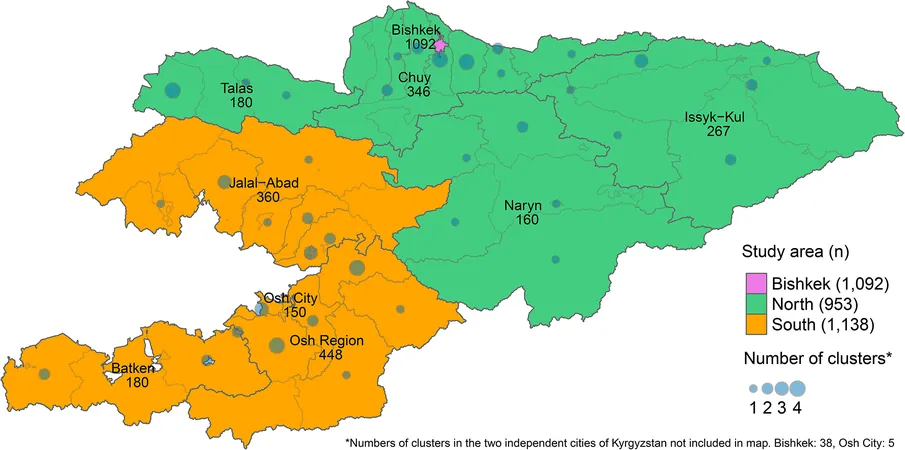
The Battle Against Hepatitis B in Kyrgyzstan: A Landmark Study Uncovers Vaccination's Triumph and Challenges in 2022
2025-01-22
Author: Daniel
The Battle Against Hepatitis B in Kyrgyzstan: A Landmark Study Uncovers Vaccination's Triumph and Challenges in 2022
In a groundbreaking study, Kyrgyzstan has highlighted the significant impact of hepatitis B vaccinations among its youth, paving the way for important policy changes and public health strategies. Hepatitis B—a virus that can lead to severe liver complications such as cirrhosis and liver cancer—remains a pressing health threat, particularly in Central Asia, where infection rates are notably higher than in other regions.
In response to the alarming prevalence of hepatitis B, the World Health Organization (WHO) set ambitious targets to eliminate viral hepatitis by 2030. Kyrgyzstan, identified as a focus country, has made strides since introducing universal vaccination for hepatitis B in 1999. This vaccination initiative aimed to curb mother-to-child transmission and early childhood infections, keeping vaccination coverage above 90% for the past two decades.
A startling statistic from the 2024 Global Hepatitis Report indicated approximately 10.6 million hepatitis B infections across Europe, with Central Asia suffering disproportionately with a death rate seven times that of Western Europe from liver complications. Despite these challenges, data from Kyrgyzstan shows a steady decline in new infections, attributed largely to the successful vaccination efforts.
The recent nationwide serosurvey of third-grade school children—which represents a critical evaluation of the vaccination program's effectiveness—was conducted in collaboration with the Ministry of Health of Kyrgyzstan and the WHO Regional Office for Europe. This extensive study involved over 3,000 children aged 9 to 10, who had received their vaccinations in childhood.
Key Findings and Implications of the Study
The results were promising: the serosurvey revealed a significant reduction in hepatitis B prevalence among vaccinated cohorts, with only five confirmed cases of chronic hepatitis B. The findings reinforced the validity of Kyrgyzstan's vaccination efforts, indicating not just a decrease in infections but also a potential pathway toward eliminating hepatitis B as a public health concern.
Despite this success, challenges remain. During the COVID-19 pandemic, the coverage for the required doses of the hepatitis B vaccine saw a decline. Furthermore, maternal screening for hepatitis B has not yet been implemented universally, raising concerns about potential infections during pregnancy.
Moving forward, the Kyrgyz government plans to enhance vaccination access not only for children but also for adults. A vaccination campaign targeting citizens aged 23 to 65 commenced in January 2023, underscoring the need for comprehensive protection across all demographics, particularly for high-risk populations.
The study's findings also shed light on the necessity of ensuring timely vaccination, especially for newborns. Out of five cases of hepatitis B, all were individuals who received their vaccinations promptly within the recommended time frame. This highlights the importance of proactive healthcare strategies aimed at improving maternal health and screening procedures.
Conclusion: A Promising Future for Hepatitis B Control in Kyrgyzstan
As Kyrgyzstan strives to meet the WHO's target of reducing hepatitis B prevalence to below 0.5% in vaccinated cohorts by 2025, the data from this serosurvey could play a pivotal role in shaping national health policies. The implications of vaccination are profound: a healthier future with significantly reduced risks of liver disease, lower healthcare costs, and improved quality of life for the population.
This serosurvey offers hope and encouragement not just for Kyrgyzstan, but for other countries grappling with similar health crises. By prioritizing vaccination and improving health infrastructure, the global fight against hepatitis B can be strengthened, potentially marking the beginning of the end for this life-threatening disease.



 Brasil (PT)
Brasil (PT)
 Canada (EN)
Canada (EN)
 Chile (ES)
Chile (ES)
 Česko (CS)
Česko (CS)
 대한민국 (KO)
대한민국 (KO)
 España (ES)
España (ES)
 France (FR)
France (FR)
 Hong Kong (EN)
Hong Kong (EN)
 Italia (IT)
Italia (IT)
 日本 (JA)
日本 (JA)
 Magyarország (HU)
Magyarország (HU)
 Norge (NO)
Norge (NO)
 Polska (PL)
Polska (PL)
 Schweiz (DE)
Schweiz (DE)
 Singapore (EN)
Singapore (EN)
 Sverige (SV)
Sverige (SV)
 Suomi (FI)
Suomi (FI)
 Türkiye (TR)
Türkiye (TR)
 الإمارات العربية المتحدة (AR)
الإمارات العربية المتحدة (AR)